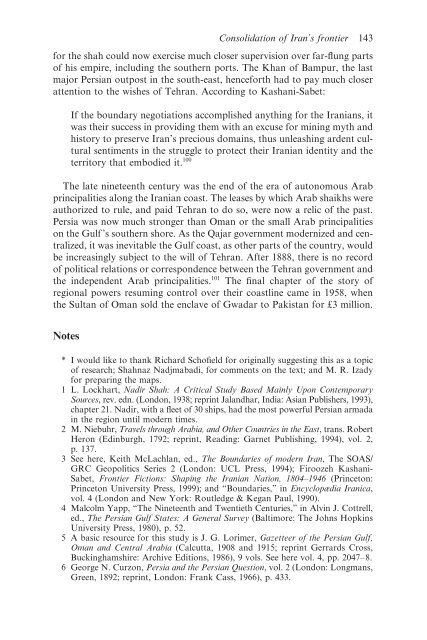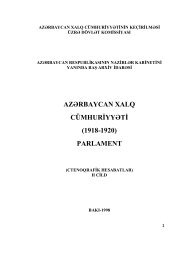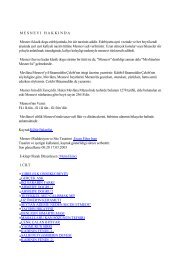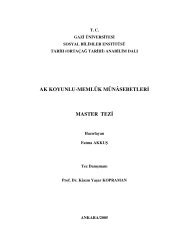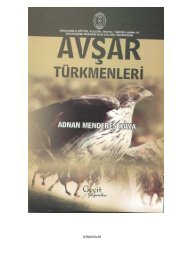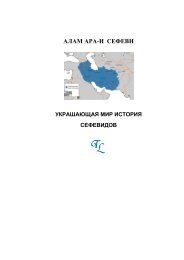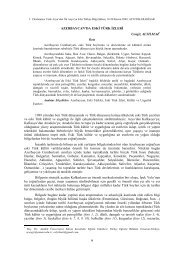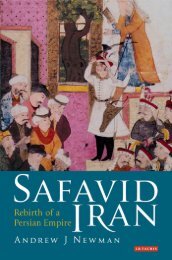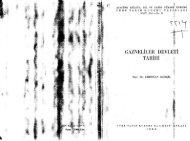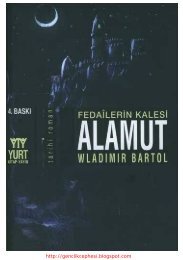Consolidation of Iran’s frontier 143for the shah could now exercise much closer supervision over far-flung partsof his empire, <strong>in</strong>clud<strong>in</strong>g the southern ports. The Khan of Bampur, the lastmajor <strong>Persia</strong>n outpost <strong>in</strong> the south-east, henceforth had to pay much closerattention to the wishes of Tehran. Accord<strong>in</strong>g to Kashani-Sabet:If the boundary negotiations accomplished anyth<strong>in</strong>g for the Iranians, itwas their success <strong>in</strong> provid<strong>in</strong>g them with an excuse for m<strong>in</strong><strong>in</strong>g myth <strong>and</strong>history to preserve Iran’s precious doma<strong>in</strong>s, thus unleash<strong>in</strong>g ardent culturalsentiments <strong>in</strong> the struggle to protect their Iranian identity <strong>and</strong> theterritory that embodied it. 100The late n<strong>in</strong>eteenth century was the end of the era of autonomous Arabpr<strong>in</strong>cipalities along the Iranian coast. The leases by which Arab shaikhs wereauthorized to rule, <strong>and</strong> paid Tehran to do so, were now a relic of the past.<strong>Persia</strong> was now much stronger than Oman or the small Arab pr<strong>in</strong>cipalitieson the Gulf ’s southern shore. As the <strong>Qajar</strong> government modernized <strong>and</strong> centralized,it was <strong>in</strong>evitable the Gulf coast, as other parts of the country, wouldbe <strong>in</strong>creas<strong>in</strong>gly subject to the will of Tehran. After 1888, there is no recordof political relations or correspondence between the Tehran government <strong>and</strong>the <strong>in</strong>dependent Arab pr<strong>in</strong>cipalities. 101 The f<strong>in</strong>al chapter of the story ofregional powers resum<strong>in</strong>g control over their coastl<strong>in</strong>e came <strong>in</strong> 1958, whenthe Sultan of Oman sold the enclave of Gwadar to Pakistan for £3 million.Notes* I would like to thank Richard Schofield for orig<strong>in</strong>ally suggest<strong>in</strong>g this as a topicof research; Shahn<strong>az</strong> Nadjmabadi, for comments on the text; <strong>and</strong> M. R. Izadyfor prepar<strong>in</strong>g the maps.1 L. Lockhart, Nadir Shah: A Critical Study Based Ma<strong>in</strong>ly Upon ContemporarySources, rev. edn. (London, 1938; repr<strong>in</strong>t Jal<strong>and</strong>har, India: Asian Publishers, 1993),chapter 21. Nadir, with a fleet of 30 ships, had the most powerful <strong>Persia</strong>n armada<strong>in</strong> the region until modern times.2 M. Niebuhr, Travels through Arabia, <strong>and</strong> Other Countries <strong>in</strong> the East, trans. RobertHeron (Ed<strong>in</strong>burgh, 1792; repr<strong>in</strong>t, Read<strong>in</strong>g: Garnet Publish<strong>in</strong>g, 1994), vol. 2,p. 137.3 See here, Keith McLachlan, ed., The Boundaries of modern Iran, The SOAS/GRC Geopolitics Series 2 (London: UCL Press, 1994); Firoozeh Kashani-Sabet, Frontier Fictions: Shap<strong>in</strong>g the Iranian Nation, 1804–1946 (Pr<strong>in</strong>ceton:Pr<strong>in</strong>ceton University Press, 1999); <strong>and</strong> “Boundaries,” <strong>in</strong> Encyclopædia Iranica,vol. 4 (London <strong>and</strong> New York: Routledge & Kegan Paul, 1990).4 Malcolm Yapp, “The N<strong>in</strong>eteenth <strong>and</strong> Twentieth Centuries,” <strong>in</strong> Alv<strong>in</strong> J. Cottrell,ed., The <strong>Persia</strong>n Gulf States: A General Survey (Baltimore: The Johns Hopk<strong>in</strong>sUniversity Press, 1980), p. 52.5 A basic resource for this study is J. G. Lorimer, G<strong>az</strong>etteer of the <strong>Persia</strong>n Gulf,Oman <strong>and</strong> Central Arabia (Calcutta, 1908 <strong>and</strong> 1915; repr<strong>in</strong>t Gerrards Cross,Buck<strong>in</strong>ghamshire: Archive Editions, 1986), 9 vols. See here vol. 4, pp. 2047–8.6 George N. Curzon, <strong>Persia</strong> <strong>and</strong> the <strong>Persia</strong>n Question, vol. 2 (London: Longmans,Green, 1892; repr<strong>in</strong>t, London: Frank Cass, 1966), p. 433.
144 Lawrence G. Potter7 On the issue of the Gulf isl<strong>and</strong>s, see three l<strong>in</strong>ked articles <strong>in</strong> Lawrence G. Potter<strong>and</strong> Gary G. Sick, eds, Security <strong>in</strong> the <strong>Persia</strong>n Gulf: Orig<strong>in</strong>s, Obstacles, <strong>and</strong> theSearch for Consensus (New York: Palgrave, 2002), pp. 135–87: “On the <strong>Persia</strong>n GulfIsl<strong>and</strong>s: An Iranian Perspective,” by Jalil Rosh<strong>and</strong>el, “The Isl<strong>and</strong>s Question: AnArabian Perspective,” by Hassan Al-Alkim, <strong>and</strong> “Anyth<strong>in</strong>g but Black <strong>and</strong>White: A Commentary on the Lower Gulf Isl<strong>and</strong>s Dispute,” by Richard Schofield.8 General sources <strong>in</strong>clude “ad 600–1800” by Roger M. Savory <strong>in</strong> Cottrell, <strong>Persia</strong>nGulf States, pp. 14–40; “The <strong>Persia</strong>n Gulf <strong>in</strong> the Late Eighteenth Century,” <strong>in</strong>J. B. Kelly, Brita<strong>in</strong> <strong>and</strong> the <strong>Persia</strong>n Gulf 1795–1880 (Oxford: Clarendon Press,1968), pp. 1–61; Sir Arnold T. Wilson, The <strong>Persia</strong>n Gulf: An Historical Sketch fromthe Earliest Times to the Beg<strong>in</strong>n<strong>in</strong>g of the Twentieth Century (London: George Allen& Unw<strong>in</strong>, 1928; repr. 1959); Thomas Miller Ricks, “Politics <strong>and</strong> Trade <strong>in</strong> SouthernIran <strong>and</strong> the Gulf, 1745–1765” (Ph.D. diss., Indiana University, 1975); WillemFloor, The <strong>Persia</strong>n Gulf: A Political <strong>and</strong> Economic History of Five Port Cities1500–1730 (Wash<strong>in</strong>gton, DC: Mage Publishers, 2006); <strong>and</strong> Peter Avery, Gav<strong>in</strong>Hambly <strong>and</strong> Charles Melville, eds., The Cambridge History of Iran, vol. 7: FromNadir Shah to the Islamic Republic (Cambridge: Cambridge University Press, 1991).9 Lockhart, Nadir Shah, chapter 21; Willem Floor, “The Iranian Navy <strong>in</strong> the Gulfdur<strong>in</strong>g the Eighteenth Century,” Iranian Studies 20/1 (1987): 31–53.10 Lockhart, Nadir Shah, pp. 219–20.11 Ricks, “Politics <strong>and</strong> Trade <strong>in</strong> Southern Iran,” p. 389.12 John R. Perry, Karim Khan Z<strong>and</strong>: A History of Iran, 1747–1779, Publicationsof the Center for Middle Eastern Studies 12 (Chicago: University of ChicagoPress, 1979), p. 151.13 Yapp, “The N<strong>in</strong>eteenth <strong>and</strong> Twentieth Centuries,” pp. 44–6 <strong>and</strong> more detail <strong>in</strong>Ahmad Mustafa Abu-Hakima, History of Eastern Arabia 1750–1800 (Beirut, 1965;repr<strong>in</strong>t London: Probstha<strong>in</strong>, 1988). See also B. J. Slot, The Arabs of the Gulf,1602–1784: an alternative approach to the early history of the Arab Gulf States<strong>and</strong> the Arab peoples of the Gulf, ma<strong>in</strong>ly based on sources of the Dutch East IndiaCompany (Leidschendam, 1993) <strong>and</strong> Willem Floor, The Pesian Gulf: The Riseof the Gulf Arabs: The Politics of Trade on the <strong>Persia</strong>n Littoral, 1747–1792 (Wash<strong>in</strong>gton,DC: Mage, 2007).14 It was ironic that “the pr<strong>in</strong>cipal legacy of Nadir’s campaigns aga<strong>in</strong>st Oman wasthe future rise of the family of Bu Sa‘id as rulers of Oman <strong>and</strong> Zanzibar.” RoseGreaves, “Iranian Relations with the European Trad<strong>in</strong>g Companies, to 1798,”<strong>in</strong> Avery et al., The Cambridge History of Iran, vol. 7, pp. 352–3.15 Willem Floor, “The Rise <strong>and</strong> Fall of the Banu Ka‘b: A Borderer State <strong>in</strong> SouthernKhuzestan,” Iran 44 (2006), pp. 277–315.16 Shahn<strong>az</strong> R<strong>az</strong>ieh Nadjmabadi, personal communication, April 11, 2006.17 Shahn<strong>az</strong> R<strong>az</strong>ieh Nadjmabadi, “The Arab Presence on the Iranian Coast of the<strong>Persia</strong>n Gulf,” <strong>in</strong> Lawrence G. Potter, ed., The <strong>Persia</strong>n Gulf <strong>in</strong> History (NewYork: Palgrave Macmillan, 2008).18 Ricks, “Politics <strong>and</strong> Trade <strong>in</strong> Southern Iran,” pp. 74–6.19 Robert Geran L<strong>and</strong>en, Oman s<strong>in</strong>ce 1856: Disruptive Modernization <strong>in</strong> a TraditionalArab Society (Pr<strong>in</strong>ceton: Pr<strong>in</strong>ceton University Press, 1967), p. 24.20 “ ‘Qawasim’ was a term loosely applied to denote the tribes subject to theauthority of the Qasimi shaikhs of Sharjah <strong>and</strong> Ras al-Khaima, but it appliedmore strictly to the shaikhly family itself. How many tribes acknowledged theauthority of the Qasimi shaikhs, what their strength was, or how they were distributed,are difficult questions to answer.” (Kelly, Brita<strong>in</strong> <strong>and</strong> the <strong>Persia</strong>n Gulf,pp. 17–18).21 Nadjmabadi, “Arab Presence on the Iranian Coast.”22 Kelly, Brita<strong>in</strong> <strong>and</strong> the <strong>Persia</strong>n Gulf, pp. 19 <strong>and</strong> 184–5. Perry, Karim Khan Z<strong>and</strong>,p. 152, gives the year 1760 as the start of Qasimi <strong>in</strong>fluence on Qeshm.
- Page 2 and 3:
War and Peace in Qajar PersiaPersia
- Page 4 and 5:
War and Peace inQajar PersiaImplica
- Page 6 and 7:
ContentsList of figuresContributors
- Page 8 and 9:
Figures5.1 Omani enclaves 1305.2 Ar
- Page 10 and 11:
Contributor listMansoureh Ettehadie
- Page 12:
AcknowledgementsThis volume grew ou
- Page 15 and 16:
2 Roxane Farmanfarmaianrepresented
- Page 17 and 18:
4 Roxane Farmanfarmaianchapter in t
- Page 19 and 20:
6 Roxane FarmanfarmaianThus, two si
- Page 21 and 22:
8 Roxane Farmanfarmaiangaining grea
- Page 23 and 24:
10 Roxane Farmanfarmaiantough deals
- Page 25 and 26:
12 Roxane FarmanfarmaianIranian geo
- Page 27 and 28:
14 Peter W. Averyin Shiraz and cont
- Page 29 and 30:
16 Peter W. Averybut the invasion w
- Page 32:
Part IWar
- Page 35 and 36:
22 Manoutchehr M. Eskandari-Qajarth
- Page 37 and 38:
24 Manoutchehr M. Eskandari-Qajarap
- Page 39 and 40:
26 Manoutchehr M. Eskandari-Qajarmi
- Page 41 and 42:
28 Manoutchehr M. Eskandari-Qajarth
- Page 43 and 44:
30 Manoutchehr M. Eskandari-Qajardo
- Page 45 and 46:
32 Manoutchehr M. Eskandari-QajarIn
- Page 47 and 48:
34 Manoutchehr M. Eskandari-Qajarco
- Page 49 and 50:
36 Manoutchehr M. Eskandari-QajarTh
- Page 51 and 52:
38 Manoutchehr M. Eskandari-Qajarth
- Page 53 and 54:
40 Manoutchehr M. Eskandari-Qajarth
- Page 55 and 56:
42 Manoutchehr M. Eskandari-Qajarop
- Page 57 and 58:
44 Manoutchehr M. Eskandari-Qajarbe
- Page 59 and 60:
46 Manoutchehr M. Eskandari-Qajarva
- Page 61 and 62:
48 Stephanie Cronincapacity and res
- Page 63 and 64:
50 Stephanie Croninforces of the es
- Page 65 and 66:
52 Stephanie CroninPART ONE: THE QA
- Page 67 and 68:
54 Stephanie Croninprincipally on h
- Page 69 and 70:
56 Stephanie CroninThe French offic
- Page 71 and 72:
58 Stephanie CroninEuropean alignme
- Page 73 and 74:
60 Stephanie Croninthe authorities
- Page 75 and 76:
62 Stephanie Croninin the revolutio
- Page 77 and 78:
64 Stephanie Croninof power and sta
- Page 79 and 80:
66 Stephanie Croninliving and the m
- Page 81 and 82:
68 Stephanie Croninconsequences for
- Page 83 and 84:
70 Stephanie Croninrevolution was a
- Page 85 and 86:
72 Stephanie CroninNew British miss
- Page 87 and 88:
74 Stephanie CroninBrigade to a Div
- Page 89 and 90:
76 Stephanie Croninwithout the sove
- Page 91 and 92:
78 Stephanie Croninaccounting devic
- Page 93 and 94:
80 Stephanie Croninbut also faced a
- Page 95 and 96:
82 Stephanie Cronindetermined on th
- Page 97 and 98:
84 Stephanie Cronin15 For a discuss
- Page 99 and 100:
86 Stephanie Cronin55 The Anglo-Rus
- Page 101 and 102:
3 The Turko-Persian War1821-1823Win
- Page 103 and 104:
90 Graham WilliamsonThe resultant w
- Page 105 and 106: 92 Graham Williamsonprovincial forc
- Page 107 and 108: 94 Graham WilliamsonThe field armyO
- Page 109 and 110: 96 Graham Williamsonnot hold out mu
- Page 111 and 112: 98 Graham Williamsonoften in arrear
- Page 113 and 114: 100 Graham Williamsonthan any desig
- Page 115 and 116: 102 Graham WilliamsonThere were ove
- Page 117 and 118: 104 Graham Williamsonone should not
- Page 119 and 120: Table 3.2 Persian regional armies (
- Page 121 and 122: 108 Graham WilliamsonIranian influe
- Page 123 and 124: 4 Social networks andborder conflic
- Page 125 and 126: 112 Vanessa MartinPersian troops on
- Page 127 and 128: 114 Vanessa Martinof comparatively
- Page 129 and 130: 116 Vanessa MartinTHE ROLE OF SOCIA
- Page 131 and 132: 118 Vanessa MartinThe Shah’s negl
- Page 133 and 134: 120 Vanessa Martinborder or any oth
- Page 135 and 136: 122 Vanessa Martin44 No. 38, 2 June
- Page 138 and 139: 5 The consolidation of Iran’sfron
- Page 140 and 141: Consolidation of Iran’s frontier
- Page 142 and 143: Consolidation of Iran’s frontier
- Page 144 and 145: Consolidation of Iran’s frontier
- Page 146 and 147: Consolidation of Iran’s frontier
- Page 148 and 149: Consolidation of Iran’s frontier
- Page 150 and 151: Figure 5.2 Arab principalities
- Page 152 and 153: Consolidation of Iran’s frontier
- Page 154 and 155: Consolidation of Iran’s frontier
- Page 158 and 159: Consolidation of Iran’s frontier
- Page 160 and 161: Consolidation of Iran’s frontier
- Page 162 and 163: 6 Narrowing the frontierMid-ninetee
- Page 164 and 165: Narrowing the frontier 151witnessed
- Page 166 and 167: Figure 6.1 The 1843 borderlands sta
- Page 168 and 169: Narrowing the frontier 155And the S
- Page 170 and 171: Figure 6.2 The 1850 Williams line a
- Page 172 and 173: Narrowing the frontier 159elicited
- Page 174 and 175: Narrowing the frontier 161travellin
- Page 176 and 177: Narrowing the frontier 163be found
- Page 178 and 179: Narrowing the frontier 165A similar
- Page 180 and 181: Narrowing the frontier 167and accep
- Page 182 and 183: Narrowing the frontier 169Perhaps t
- Page 184 and 185: Narrowing the frontier 171By this s
- Page 186 and 187: Narrowing the frontier 17346 For a
- Page 188 and 189: Crime, security, and insecurity 175
- Page 190 and 191: Crime, security, and insecurity 177
- Page 192 and 193: Crime, security, and insecurity 179
- Page 194 and 195: Crime, security, and insecurity 181
- Page 196 and 197: 8 Merchants without bordersTrade, t
- Page 198 and 199: Merchants without frontier 185the m
- Page 200 and 201: Merchants without frontier 187and d
- Page 202 and 203: Merchants without frontier 189photo
- Page 204 and 205: Merchants without frontier 191their
- Page 206 and 207:
Merchants without frontier 193In an
- Page 208 and 209:
Figure 8.1Seated, first from left:
- Page 210 and 211:
Figure 8.3Seated: Hajj Mohammad-Taq
- Page 212 and 213:
Figure 8.5 Taken in Hajj Hasan Jour
- Page 214 and 215:
Merchants without frontier 201Figur
- Page 216 and 217:
Merchants without frontier 203Studi
- Page 218 and 219:
Merchants without frontier 20516 Me
- Page 220 and 221:
Merchants without frontier 207and t
- Page 222 and 223:
Merchants without frontier 209or pu
- Page 224 and 225:
Merchants without frontier 211It ca
- Page 226 and 227:
9 The politics of concessionReasses
- Page 228 and 229:
The politics of concession 215gradu
- Page 230 and 231:
The politics of concession 217Shah,
- Page 232 and 233:
The politics of concession 219assig
- Page 234 and 235:
The politics of concession 221compa
- Page 236 and 237:
The politics of concession 223gross
- Page 238 and 239:
The politics of concession 225the B
- Page 240 and 241:
The politics of concession 227as th
- Page 242 and 243:
IndexAbbas Mirza, Crown Prince 6, 1
- Page 244 and 245:
Index 231Gulf Arabs 127-9Gwadar 136
- Page 246 and 247:
Index 233policy in Persian Gulf 131


